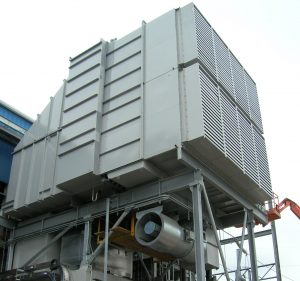10Mins
Understanding the impacts of poor air filtration on gas turbine performance
10Mins
Traditional systems
Pulse cleaning systems were introduced to help combat the challenges faced in high dust environments and have been in use for many years in gas turbine filtration systems. Predominantly designed in a cylindrical or conical geometry and known as ‘cartridge’ or ‘canister’ systems, these pulse filters have been widely adopted by OEMs and therefore become a standard across many installations.
The design concept of a cartridge filtration system is simple. Atmospheric air is drawn into and through the filter cartridge, where particulates are captured by the filter media. The filters are then cleaned using a reverse pulse of compressed air, usually triggered by an increase in differential pressure. Once differential pressure returns to an acceptable level, the cleaning cycle stops. However, the design has its drawbacks, especially in high dust environments. The problem occurs when the cartridges become heavily loaded with dust. Pulsing (the reverse pulse of compressed air) will remove some of the particles, but many of these can become re-entrained, especially when in a crossflow design with dust falling to the cartridge below.
High dust and high humidity
In high dust environments, the volume of dust can become too much for the pulse system to ‘keep up with’ and so high differential pressure is reached quickly. To compound this issue, when filters loaded with dust are exposed to high levels of moisture, the moisture can be absorbed by the particles themselves. These ‘hygroscopic’ particles can swell up to 10 times their original diameter blocking the media and increasing the differential pressure further. Dependent on particle composition, this may also form hard ‘caking’ which is difficult to pulse clean and can result in differential spiking.

Bulk particle removal
In high dust environments the ideal scenario is to remove the bulk of the particulates before they reach the filter element. The filter media is designed to capture particles at the sub-micron level. These are the particles that can do the most harm to the compressor section of the gas turbine and so, by removing bulk particles it allows the filter media to do its job more effectively and helps to elevate the effect of humidity.
One solution provided by AAF is to use a design which incorporates a secondary air system. The ASC Filtration System removes around 75% of the dust through inertial separation and positive extraction into the secondary air system. With only 25% of the dust coming into contact with the filters, the filter media does not load as quickly. This means lower levels of dust on the filter and a lessening of the effect of humidity on the particles, which in turn extends the in-service life of the filters. These ASC filtration systems also incorporate reverse pulse cleaning. When pulsed with compressed air, the particles released from the filter are immediately extracted by the secondary air system. This eliminates the risk of dust being re-entrained by adjacent filters which in turn keeps the differential pressure to acceptable level for longer.
Conclusion
Air filtration systems that incorporate a secondary air system offer a unique advantage in high dust environments. The filter elements are not put under the same strain and demands found in traditional intake systems due to the fact that 75% of the airborne particles are removed through the secondary air system. This creates many benefits to the operator including a longer filter life, lower pressure drop, reduced compressed air usage, and a more reliable and dependable filtration system. It is also a particular advantage in humid environments, where particles must be removed regularly from the filter media to avoid hygroscopic particles swelling up to 10 times their original diameter, blocking the media, and resulting in differential pressure spiking.